THE OPPOSITE CONTINENT
For the ocean there was at that time navigable; for in front of the mouth which you Greeks call, as you say, 'the pillars of Heracles,' there lay an island which was larger than Libya and Asia together; and it was possible for the travellers of that time to cross from it to the other islands, and from the islands to the whole of the continent over against them which encompasses that veritable ocean. For all that we have here, lying within the mouth of which we speak, is evidently a haven having a narrow entrance; but that yonder is a real ocean, and the land surrounding it may most rightly be called, in the fullest and truest sense, a continent. [Tim. 24e-25a].
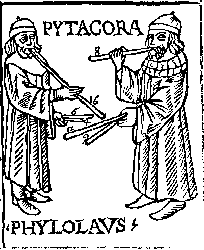
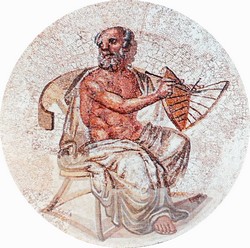
ETYMOLOGY: ANAXIMANDER AND PHILOLAUS
Plato's concentric rings of sea and earth around the Athenian citadel find a macrocosmic counterpart in the "opposite continent" in the quote above, part of which was reduced to subjection by the rulers of Atlantis.
F.M. Cornford, in his commentary on the Timaeus, notes: -
It's not hard to see the resemblance between this ἤπειρος or ἄπειρος and ἄπειρον, the "boundless," which the early Milesian thinker Anaximander used to describe the primordial element, eternal and infinite, which never ages nor decays but always brings forth other materials, bringing forth innumerable worlds and within which all things perish. The Pythagorean Philolaus suggested two initial principles, one being the boundless and the other limitable, and proposed that the heavens drew in material from the boundless (time, breath and the void), producing bubble-like areas which became the different parts of the earth.
THE ODYSSEY
Though no trace of such an opposite continent enclosing the river Oceanus is present on the maps of the aforementioned Anaximander or Hecataeus, and Hesiod's description of the eccentric course of the Styx has it falling off a precipice, presumably at the edge of the world, tantalising clues to the notion of the opposite continent can be found in the Odyssey: -

Whether this continent was inhabited or not is not explicitly stated by Plato. It may well be that, if it is viewed as a domain for the gods only and their chosen tablemates, Atlantis' interest in the region reflects their early status as inheritors of Poseidon: this god was wont to visit the Ethiopians according to the Odyssey, and it is during his return from their lands that he is enraged to see Odysseus travelling from Ogygia to Scheria [5.282], having been preoccupied there since the council at the beginning of the tale [1.22-23].
PLATO AND THE PHAEACIANS
On the subject of the Phaeacians, they - along with their relatives the Cyclopes and Gigantes - are described as having a particularly close relationship to the gods. The same is true of the dwellers in the world of the aether-breathers in Plato's Phaedo: -
HOMER, ODYSSEY [7.200 ff.]
"For in the past [the gods] have always shown themselves to us [i.e. the Phaeacians] without disguise when we have offered them their sumptuous sacrifices; and at our banquets they sit at our side. Even when a traveller meets them on his lonely way, they make no concealment; for we are special to them, like the Cyclopes and the wild tribes of the Giants."
PLATO, PHAEDO [111ac].
"And there are many animals upon it, and men also, some dwelling inland, others on the coasts of the air, as we dwell about the sea, and others on islands, which the air flows around, near the mainland; and in short, what water and the sea are in our lives, air is in theirs, and what the air is to us, ether is to them. [...] And they have sacred groves and temples of the gods, in which the gods really dwell, and they have intercourse with the gods by speech and prophecies and visions, and they see the sun and moon and stars as they really are, and in all other ways their blessedness is in accord with this."
PLATO, TIMAEUS [24e-25a].
"For the ocean there was at that time navigable; for in front of the mouth which you Greeks call, as you say, 'the pillars of Heracles,' there lay an island which was larger than Libya and Asia together; and it was possible for the travellers of that time to cross from it to the other islands, and from the islands to the whole of the continent over against them which encompasses that veritable ocean. For all that we have here, lying within the mouth of which we speak, is evidently a haven having a narrow entrance; but that yonder is a real ocean, and the land surrounding it may most rightly be called, in the fullest and truest sense, a continent. Now in this island of Atlantis there existed a confederation of kings, of great and marvellous power, which held sway over all the island, and over many other islands also and parts of the continent."
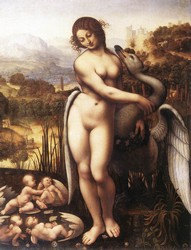
HERODORUS AND THE MEN ON THE MOON
Plato's idea of a land above the earth is also found in the work of the 5th century writer Herodorus of Heraclea Pontica, who posited that the Nemean lion [BNJ 31 F 4] and possibly vultures [BNJ 31 F 22ab] came from an "upper earth" while the egg which bore Helen of Troy, according to Neocles of Croton, came from the moon, about whose inhabitants, Herodorus [BNH 31 F 21] says: -
The putative inhabitants of the moon also appear in the philosophical works of Pythagoreans such as the previously-mentioned Philolaus [F 31 Graham, apud Aëtius, P 2.30.1, S 1.26.4 (S) (A20)]: -
Philolaus also states that "the destruction of the world is twofold: one by the flowing of fire from the heaven, the other from water from the moon," an interesting concept which Plato would likely have been familiar with, though no statement of lunar involvement in the floods which destroyed Atlantis or the Deucalion event are forthcoming.
THEOPOMPUS AND PLUTARCH
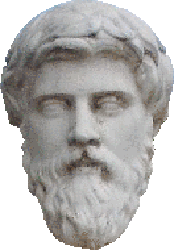
The theme of the great continent enclosing the river of Oceanus reappears in a number of authors: Theopompus, in his account of "Meropis," which survives in Claudius Aelianus' Various History [3.18], states: "[t]here was but one Continent only, which was beyond this world, and that as to magnitude it was infinite," wherein dwell the subjects of his discussion. Though it is quite possible that Theopompus' purpose was, at least in part, to ridicule Plato's account of Atlantis, this represents a major difference between the two works, suggesting that Theopompus was also influenced to some extent by Plato's outlining of the existence of such a land.
Additionally, Plutarch, in his On the Face on the Moon [26], also describes a "great mainland, by which the great ocean is encircled," which can be reached by travelling "in the general direction of the summer sunset" via five islands, the first two of which are Britain and Homer's Ogygia. Instead of Theopompus' powerful and bizarre inhabitants, Plutarch is more prosaic, and places a Greek colony on this mainland: -
It should be noted that both Theopompus and Plutarch echo Plato in couching their descriptions within philosophical dialogues between named individuals. In the case of Theopompus, these are Silenus, the mythical follower of Dionysus who was depicted as being permanently in his cups, and the Phrygian ruler Midas, which serves to establish his account as, in some measure, a pastiche. Plutarch - whose description of "streams [...] discharged by the great land-mass [which] produce alluvial deposits, thus giving density and earthiness to the sea, which has been thought actually to be congealed" echoes Aristotle's assertion that "the greatest volume of water flows from the higher regions in the north. Their alluvium makes the northern seas shallow, while the outer seas are deeper" [Meteorology 2.1] - has his Carthaginian Sulla describe an encounter with an ambassador from the continent who furnished him with the details related in the dialogue.
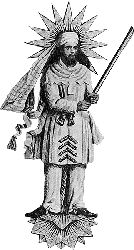
ZOROASTER AND HIS FOLLOWERS
A third Greek reference to a continent survives in a scholion on the Platonic work Alcibiades I, which states that: -
That the Iranian prophet is intended is obvious, and it is to the followers of the religion he founded, and their sacred texts, that we now turn. The Mihr Yasht [4.15], from the Khorda Avesta [10], mentions a variety of exotic lands: -
The nature of these toponyms as representing islands in or around an encircling ocean appears in the much later commentary on the geography of the Avestas from the Bundahishn [11.2-6]: -
Also worth noting is the presence in Zoroastrian cosmology of a great mountain, the source of all mountains, known as Hara, which both serves as an axis mundi and surrounds the known world. Perhaps such ideas influenced Plato's depiction of his more blessed lands where his forms were more closely understood.
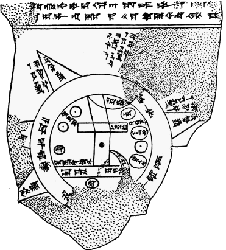
THE MESOPOTAMIAN MAPPA MUNDI
A possible analogue - perhaps even source - of the Greek and Persian notions of islands in an encircling ocean can be found in a Babylonian mappa mundi of around 600 BC, which takes the form of a circular central land mass enclosed by the world ocean (marratu), around which a number of triangular lands (nagu) are shown, some of which have surviving descriptions which correspond to a number of the places on Odysseus' itinerary: an island of permanent darkness; one which is constantly in light; and another inhabited by the dawn. These would thus correspond to the lands of the Cimmerians and Laestrygonians, and Circe's island of Aeaea respectively.
PURANIC COSMOLOGY
By contrast, Indian cosmology - for example, that described in the Vishnu Purana, which dates to the centuries after Plato - envisages a number of concentrically-arranged oceans and landmasses. The known world formed a part of the great central continent of Jambu-dwípa, which was centred upon Mount Meru. From Meru, it radiated outwards into four points, with India (Bhárata) and its surroundings on the southern point. Outside Jambu-dwípa lay an ocean of salt water, Lavańa, beyond and surrounding which was another continent, Plaksha-dwípa. This was again surrounded by an ocean surrounded by land, with seven of each in total.
ÚTGARÐR - A NORSE "OPPOSITE CONTINENT?"
It is also worth noting the Norse Útgarðr or Útgarðar - a stronghold of a particularly conceptually-frightening group of jötnar, a group who are usually depicted as enemies of the Norse gods. The name of the place means "outer enclosure," and can be contrasted with Miðgarðr (the "middle enclosure"), the world of men. According to Raymond H. Ramsay: "[t]he medieval Norsemen believed in a flat earth, with the Atlantic as a landlocked sea except for the Skuggifjord, a gap through which the Atlantic flowed out into the great Ocean surrounding the world." Skuggifjord (skuggi being Icelandic for "shadow" or "shade") appears in Örvar-Odds saga as a location in Helluland (conventionally Baffin Island), where the title character's most abiding foe, Ögmund Tussock - variously described as the "renegade leader" of an kingdom of outlaws, or "half-man, half-wraith, created by the powers of evil to avenge Odd’s early raid on the mysterious world of Bjarmaland" - sets up home for a time. Thomas E. Lee, surveying evidence of Norse settlement around the Arnaud River on the Ungava Peninsula in Nunavik, Quebec, suggests that the Ögmund of the Saga may recall the builder of a major longhouse on Pamiok Island. According to Lee: "[the] saga [...] of Arrow Odd [...] contains a number of references to the Kingdom of Skuggifjord, in terms that seem to apply to Ungava Bay. It is tempting to think that the renegade leader, Ogmund, may have been the builder of the great longhouse on Pamiok Island, for it alone of the 6 known ruins answers the given description, while only the Payne [i.e. Arnaud] River estuary satisfies the given geographical requirements."
It remains unclear as to how Ramsay developed his notion of Skuggifjord representing a strait connecting the outer ocean with the Atlantic, though, in other Icelandic sources, the term Ginnungagap - a name which appears in the Gylfaginning cosmology as the void between the primordial Niflheimr and Múspellsheimr and scene of the creation - appears in this context: Gripla, a 15th century encyclopedia now only known through quotations, states: -
Landafræði proffers a similar accound, with an added detail: -
Geraldine Barnes, summing up these notices, states that: "Gripla [...] replaces the úthaf innfallanda ('inland sea') between Vínland and Markland, and Ginnungagap, the abyss which is said to form the bounds of ocean and earth, is located between Vínland and Greenland." It would appear that the North Atlantic was viewed by the Norse as a sea enclosed by Vínland, Africa, a putative land bridge connecting the two, and Europe, connected to an outer world ocean (if not the very limits of the planet) via Ginnungagap or Skuggifjord.
